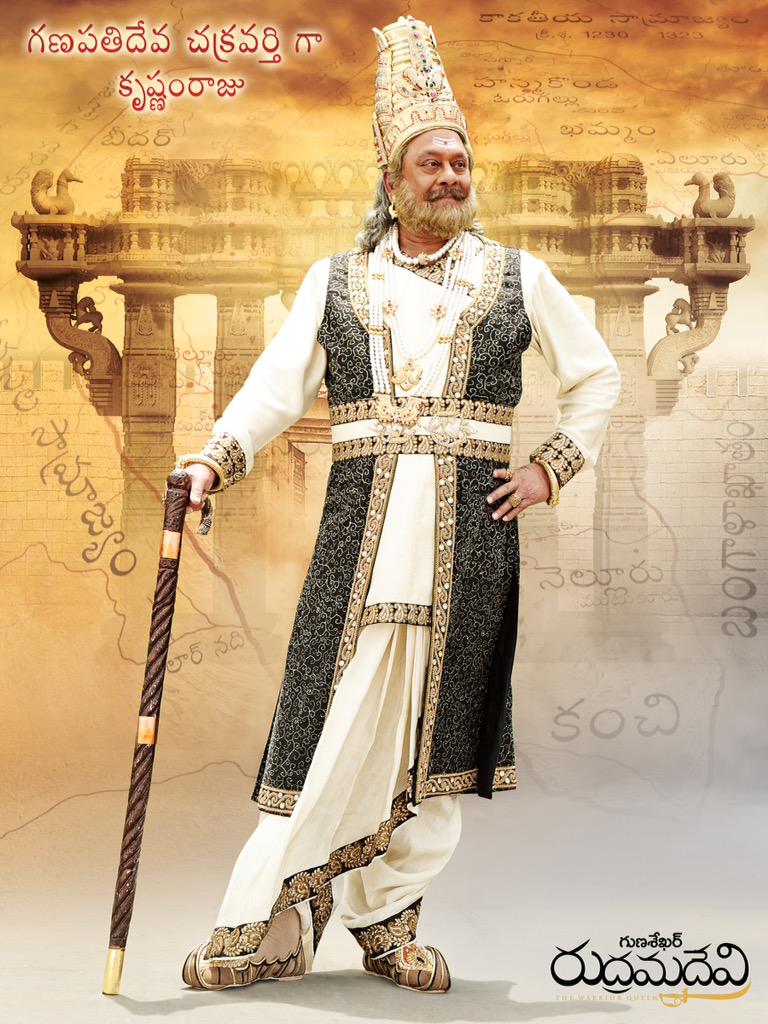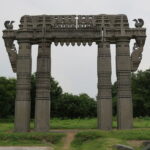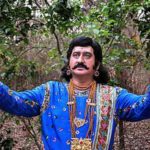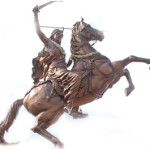With “Rudhramadevi” Released, an interest in the great Kakatiya Samrajyam of the Telugus has been rekindled in large sections of the people. As the rulers of a united kingdom of Telangana, Rayalaseema, and Kosta (Coastal Andhra), they along with Warangal, remain symbols of our inherent cultural and linguistic unity–whatever regional variation there may be.
While we have previously discussed Rani Rudrama Devi and her illustrious grandson Prataparudra Deva, we have in fact saved her father, and the best of the dynasty, for last.
Maharaja Ganapati Deva (1199-1262 C.E.) is considered the greatest of all Kakatiya rulers.
Background
The Kakatiyas Kings of Telangana remain the hallmark in the annals of Telugu history. Though consciousness as a distinct Andhra people existed from the days of the Andhra Satavahanas, it would be half a millennium before the Trilinga desa would be reunified under a native Telugu-speaking dynasty. While Prola II was the first Kakatiya subordinate to assert independence from his Chalukya suzerain, the first hints of greatness would be seen in King Rudra Deva. He would in turn be succeeded by King Mahadeva.
Raja Mahadeva’s son Prince Ganapati accompanied his father on the campaign to the Seuna Yadava kingdom of Maharashtra. When the King was killed outside the walls of Devagiri (later Daulatabad), the Prince was captured and held prisoner. The effect on the Kakatiya Kingdom was chaos, as feudatories declared independence and the government became rudderless. However, the loyal general Racharla Rudra crushed the revolts and ruled as regent until Ganapati Deva was released in 1202.
He married Naramamba and Peramamba, daughters of his newly re-instated feudatory Pinachoda of Diviseema. Ganapati Deva later had two daughters, Ganapamba (the younger) and the famous Rudramba, who would later succeed him.
Achievements
In the course of his 60 year reign, Ganapati Deva presided over many achievements. Militarily, he stands as the most gifted Kakatiya commander, and the most talented in the Dakshinapatha of that era.
- He was a skilled administrator who restored order in the Telugu Kingdom
- Wisely balanced political interests of various castes and communities
- Stabilised his empire through shrewd matrimonial alliances with subordinates such as Veerabhadra of Vengi and Betaraja of Dharanikota (Amaravati)
- Ramappa, Pakhal, and Ghanapuram lakes were all built by him.
- Famously issued his Abhaya Sasanam that reduced the duties on foreign merchants and guaranteed security to their ships. This move revitalized the trading port of Motupalli.

With respect to the military domain, he extended Kakatiya rule from Telangana to all of united Andhra Pradesh reaching as far as Chintamani in Karnataka’s Kolar District and Asika in Odisha’s Ganjam District.
Ganapati Deva re-asserted control over Velanadu and Diviseema. He reduced the Telugu Cholas of Konidena and the princes of Addanki to submission. His armies then defeated the Kalingas and annexed Vengi. Other localities in Odisha and Bastar are reputed to have come under his control due to the exploits of his lieutenants.
His greatest achievement was the conquest of Nellore (in 1228 CE) after the eponymous battle. In a spectacular victory over the combined forces of the Cholas, Seunas, & Karnatas, Ganapati Deva convincingly demonstrated Kakatiya power and restored the dynasty’s prestige—taking it to new heights.
He would win another victory there 20 years later. The great poet Tikkana Somayaji was sent from Nellore to Warangal to convince the Kakatiya king to restore Manumasiddi to his fiefdom. This mission was a success. Ganapati Deva’s forces then marched on Kanchi having won another victory at the Battle of Prayeru. Incidentally, Tikkana continued the Andhra Mahabharatamu (left unfinished by Nannaya), at the capital. This was then left for Yerrapragada (Errana) to complete.
Legacy
While settlements in Warangal existed at least since the time of Rudra, Ganapati Deva is generally credited with expanding it as fortress capital and Rudramba for completing it. Indeed, the artistry of the city’s architecture shows a balance of the granite masculinity of the walls with the artistic sensibility of a woman. 77 Nayaks commanded 77 towers in defense of the capital of the Telugus. The main fort had 45 towers and was spread out over 19 kms. The great city of Orugallu would feature centrally in the heroic decades to come. It is for this reason that Warangal was known as “Andhra Maha nagara”, part of the ancient Andhra Desa & was its medieval capital.
From the loyal Racharla Rudra to Tikkabhupala of Nellore, to Chamunda, he was assisted by many able generals. His conquest of Nellore in particular stands as possibly his greatest accomplishment.
While he unluckily met his first, and only, military defeat to Sundara Pandya I in his final years as an aged king, his daughter Rudramba would eventually redeem him and restore Kakatiya prestige. Indeed, to have been undefeated for so long a reign, save this final war, is testament to Ganapati’s military abilities.
Administratively, a number of key actions took place during his reign, notably his abhaya sasanam. Niyogi Brahmins were also appointed as karnams (village accountants) in this period.
Artistically, Chalukya structures and motifs were apparent until Ganapati Deva, under whom a true Kakatiya style emerged. The standout markers of Kakatiya architecture are artistry of the pillars (stambha),large variety of designs, lustrous polish, and fine execution of detail.
Architecture of Warangal and the Kakatiyas in general followed traditional Silpa/Agama works such as Mayamata, Manasara, Vastu Vidya of Viswakarma, and Karanagama. Building materials were primarily granite, sandstone, and periodically limestone. The concept of Torana previously received great patronage among Buddhists, and it reached its zenith at Warangal with its keerthi-toranas (4 in number). The Ramappa Temple, constructed during his reign, is testament to his contribution outside the capital, and the Svayambhunatha Temple and Keerthi Torana (gateways) testament to architectural splendour within.
Finally, Ganapati Deva honoured the ancient tradition of Dharmic Kings and abdicated in a timely fashion in favour of a qualified successor. Though his formal rule ended in 1262, he would live on until 1269. While his daughter and great-grandson remain more famous today, the greatest ruler of the Kakatiya dynasty was in fact Rudrama’s father.
For 62 years, his brilliant reign ushered in an era of glory in the Trilinga desa. It is Maharaja Ganapati Deva who re-united the Andhras after half a millennium of division. As such, this great personality is remembered not only as the greatest of the Kakatiyas, but as:
The Unifier of the Telugus
References:
- Rao, P.R. History and Culture of Andhra Pradesh. New Delhi. Sterling Publishers. 1994
- Prasad, Durga. History of the Andhras. Don Bosco Press: Guntur. 1988
- Kumari, M.Krishna. Social and Cultural Life in Medieval Andhra. Discovery: New Delhi. 1990








